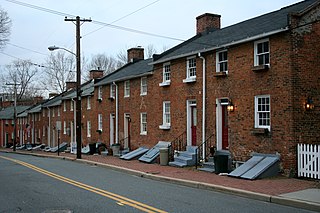
Oella is a mill town on the Patapsco River in western Baltimore County, Maryland, United States, located between Catonsville and Ellicott City. It is a 19th-century village of millworkers' homes.
Muirkirk is an unincorporated community in northern Prince George's County, Maryland, United States, located between Baltimore and Washington in the central part of the state.
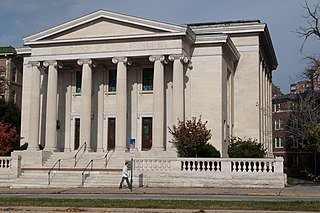
First Church of Christ, Scientist, located at 102 West University Parkway, across from the campus of Johns Hopkins University, in the Tuscany-Canterbury neighborhood of Baltimore, Maryland, in the United States is an historic structure that on December 27, 1982, was added to the National Register of Historic Places.

Seton Hill Historic District is a historic district in Baltimore, Maryland. It was listed on the National Register of Historic Places in 1975.

The Wesley Chapel Methodist Episcopal Church in Eldersburg, Maryland is a characteristic small church of the period, with uncoursed stone rubble construction and a simple plan. The interior is a single barrel-vaulted room. It was erected to serve one of the earliest Methodist congregations in Carroll County, and hence in the United States, as Carroll County was a birthplace of Methodism in America.

Bethlehem Methodist Episcopal Church is a historic Methodist church located at Bethlehem, Taylor's Island, Dorchester County, Maryland. It was built in 1857, and is a gable-front common bond brick church across the road from a mid-19th century cemetery.

Mount Gilboa Chapel is a historic African Methodist Episcopal Church located in Oella, Baltimore County, Maryland. It is a small stone church measuring 28 feet by 42 feet, built about 1859 by free African Americans. The front façade is ashlar masonry, but the sides and rear are of rubble.
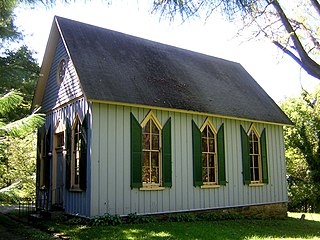
St. John's Church is a historic A.U.M.P. church located in Ruxton, Baltimore County, Maryland.
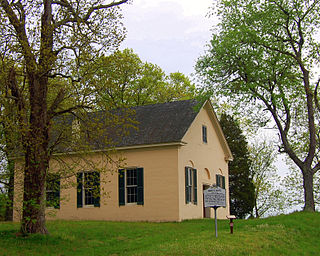
Dudley's Chapel is a historic Methodist church located at Sudlersville, Queen Anne's County, Maryland. It was built in 1783 and is a simple brick structure with a moderately pitched gable roof. A coat of stucco was added in 1883, covering all of the original brickwork. The chapel has a prominent place in the early history of the Methodist Church in Maryland. It is one of the earliest surviving Methodist churches in Maryland, and was the first Methodist church built in Queen Anne's County. Many of the prominent early leaders of the Methodist Church are known to have preached both at Dudley's including Francis Asbury, Thomas Coke, Richard Whatcoat, Jesse Lee, and Freeborn Garrettson.
St. John's Methodist Episcopal Church and Joshua Thomas Chapel is a historic Methodist Episcopal church complex located at Deal Island, Somerset County, Maryland. The complex consists of St. John's Methodist Episcopal Church, an 1879 frame Gothic building; Joshua Thomas Chapel, an 1850 Greek Revival frame structure; and the surrounding cemetery with 19th and 20th century burials and markers. The church features a three-story bell tower. The chapel is the oldest site in Somerset County in continuous use for Methodist meetings, which began in tents in 1828.

Madison Avenue Methodist Episcopal Church, now known as Douglas Memorial Community Church, is a historic Methodist Episcopal church located at Baltimore, Maryland, United States. It is a brick, Greek Revival, temple-fronted structure featuring four fluted Corinthian columns and built 1857–1858. The rear addition is a two-story Colonial Revival style wing dating from about 1900.

Orchard Street United Methodist Church, formerly known as Metropolitan Methodist Episcopal Church, is a historic Methodist Episcopal church located at Baltimore, Maryland, United States. It is a church built in a mixture of revival styles. It was constructed in 1837, with additions made in 1853, 1865, and 1882. The main church is Romanesque Revival, but the rear building is Romanesque with a large Gothic window in its northeastern facade. The nave is approximately 54 by 75 feet and features clerestory windows. The rear building is approximately 50 by 75 feet. The church was founded in 1825 by Truman Le Pratt, a West Indian former slave of Governor John Eager Howard. It now houses the offices of the Baltimore Urban League and is the oldest standing structure built by African-Americans in the city of Baltimore.

Sharp Street Memorial United Methodist Church and Community House is a historic United Methodist church located at Baltimore, Maryland, United States. It is an 1898 Gothic Revival stone structure of massive proportions. It features sharply pitched gables, a square parapeted 85-foot-high bell tower, lancet windows, and Gothic influenced interior decorative detailing. The Community House is a Georgian Revival influenced brick structure, four stories high and built in 1921. The congregation was organized in 1787 and was highly influential in the antebellum freedom movement, the establishment of the first black school in Baltimore after the abolition of slavery, and the movement to foster the institution of the African American Methodist church. It is known as the "Mother Church" of Black Methodism in Maryland. The National Association for the Advancement of Colored People, during their formative years, held their meetings at this historic church.
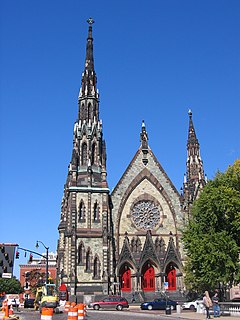
Mount Vernon Place United Methodist Church and Asbury House is a historic United Methodist church located at Baltimore, Maryland, United States. It is a Norman-Gothic-style church that was completed in 1872. It was designed by Thomas Dixon, a Baltimore architect and is built of blocks of a unique metabasalt, a green-toned Maryland fieldstone, with brownstone ornamentation. It features three spires.

Lovely Lane United Methodist Church, formerly known as First Methodist Episcopal Church, and earlier founded as Lovely Lane Chapel is a historic United Methodist church located at Baltimore, Maryland, United States.

Dorguth Memorial United Methodist Church, formerly known as Otterbein Chapel Station, Scott Street United Brethren Church, Dorguth Memorial United Brethren Church, and Dorguth Memorial Evangelical United Brethren Church, is a historic United Methodist church located at Baltimore, Maryland, United States. It was built in 1857 and is a simple, two-story gable-front brick church of the late Roman Revival style. It features a gabled roof with a pedimented brick cornice. Also on the property is the parish house added in 1868.> The church was named for Mrs. Frederick Dorguth, who in 1936 left money for extensive renovations. Dorguth UMC closed its doors in 2001.

Douglass Place is a group of historic rowhouses located at Baltimore, Maryland, United States. Built in 1892, it represents typical "alley houses" of the period in Baltimore, two narrow bays wide, two stories high over a cellar, with shed roofs pitched to the rear. Italianate influence is reflected in their segmental-arched window and door openings, and in the simple molded sheet metal cornices which crown the buildings. Frederick Douglass (1818-1895) constructed the five buildings as rental housing for blacks in the Fells Point area of Baltimore, where he had resided from the 1820s to 1838. The site was the location of the Dallas Street Station Methodist Episcopal Church, which he had attended while living in the area.
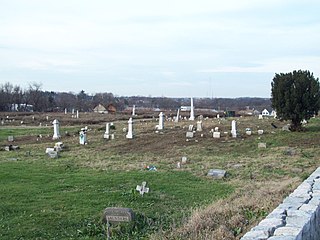
Mount Auburn Cemetery is a historic African American cemetery and national historic district in Baltimore, Maryland, United States. Overlooking the Middle Branch of the Patapsco River to the east, Baltimore's Downtown to the north and railroad tracks to the south, Mt. Auburn Cemetery is surrounded by the Cherry Hill, Westport, Mt. Winans and Lakeland communities.

Green Spring Valley Historic District is a national historic district near Stevenson in Baltimore County, Maryland, United States. It is a suburban area of Baltimore that acquires significance from the collection of 18th, 19th, and early 20th century buildings. The park-like setting retains a late 19th-early 20th century atmosphere. At the turn of the 20th century, the Maryland Hunt Cup and the Grand National Maryland steeplechase races were run over various parts of the valley. The Maryland Hunt Cup, which began as a competition between the Green Spring Valley Hunt and the Elkridge Hunt, traditionally started at Brooklandwood, the previous home of Charles Carrol of Carrollton with the finish across Valley Road at Oakdene, at that time the home of Thomas Deford, which remains a private residence
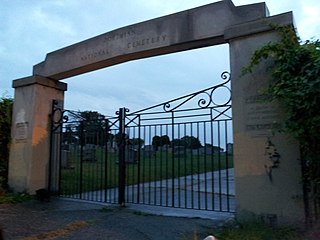
Bohemian National Cemetery, also known as Oak Hill Cemetery, is a cemetery located at 1300 Horners Lane, Armistead Gardens in East Baltimore, Maryland.























